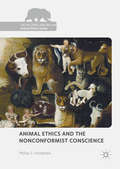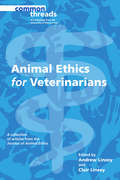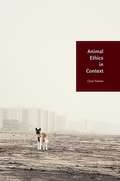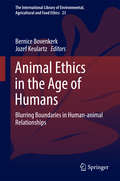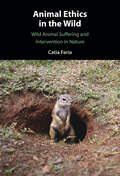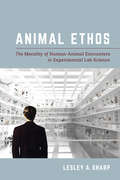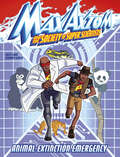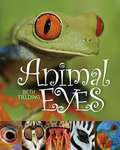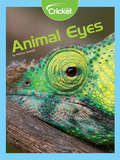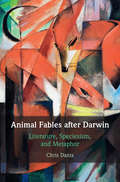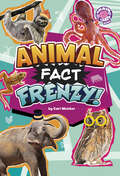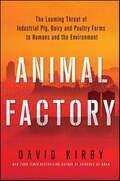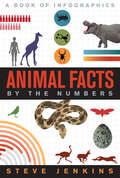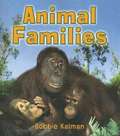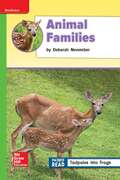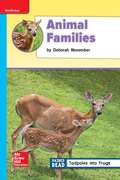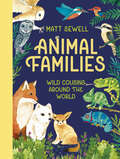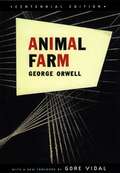- Table View
- List View
Animal Ethics and the Nonconformist Conscience (The Palgrave Macmillan Animal Ethics Series)
by Philip J. SampsonThis book explores the religious language of Nonconformity used in ethical debates about animals. It uncovers a rich stream of innovative discourse from the Puritans of the seventeenth century, through the Clapham Sect and Evangelical Revival, to the nineteenth century debates about vivisection. This discourse contributed to law reform and the foundation of the RSPCA, and continues to flavour the way we talk about animal welfare and animal rights today. Shaped by the "nonconformist conscience", it has been largely overlooked. The more common perception is that Christian “dominion” authorises the human exploitation of animals, while Enlightenment humanism and Darwinian thought are seen as drawing humans and animals together in one "family". This book challenges that perception, and proposes an alternative perspective. Through exploring the shaping of animal advocacy discourses by Biblical themes of creation, fall and restoration, this book reveals the continuing importance of the nonconformist conscience as a source to enrich animal ethics today. It will appeal to the animal studies community, theologians and early modern historians.
Animal Ethics for Veterinarians (Common Threads)
by Andrew Linzey Clair LinzeyVeterinarians serve on the front lines working to prevent animal suffering and abuse. For centuries, their compassion and expertise have improved the quality of life and death for animals in their care. However, modern interest in animal rights has led more and more people to ask questions about the ethical considerations that lie behind common veterinary practices. This Common Threads volume, drawn from articles originally published in the Journal of Animal Ethics (JAE), offers veterinarians and other interested readers a primer on key issues in the field. Essays in the first section discuss aspects of veterinary oaths, how advances in animal cognition science factor into current ethical debates, and the rise of complementary and alternative veterinary medicine and its relationship to traditional veterinary medicine. The second section continues with an essay that addresses why veterinarians have an obligation to educate animal caregivers to look past "cuteness" in order to treat all animals with dignity. The collection closes with three short sections focusing on animals in farming, trade, and research ”areas where veterinarians encounter conflicts between their job and their duty to advocate and care for animals. Contributors: Judith Benz-Schwarzburg, Vanessa Carli Bones, Grace Clement, Simon Coghlan, Priscilla N. Cohn, Mark J. Estren, Elisa Galgut, Eleonora Gullone, Matthew C. Halteman, Andrew Knight, Drew Leder, Andrew Linzey, Clair Linzey, Kay Peggs, Megan Schommer, Clifford Warwick, and James W. Yeates.
Animal Ethics in Animal Research
by Helena Röcklinsberg Mickey Gjerris Olsson I. Anna S.The use of animals in research has always been surrounded by ethical controversy. This book provides an overview of the central ethical issues focusing on the interconnectedness of science, law and ethics. It aims to make theoretical ethical reasoning understandable to non-ethicists and provide tools to improve ethical decision making on animal research. It focuses on good scientific practice, the 3Rs (replacement, reduction and refinement), ethical theories applied to specific cases and an overview of regulatory issues. The book is co-authored by experts in animal research, animal welfare, social sciences, law and ethics, and provides both animal researchers and members of animal ethics committees with knowledge that can facilitate their work and communication with stakeholders and the public. The book is written to provide knowledge, not to argue a certain position, and is intended to be used in training that aims to fulfil EU Directive 2010/63/EU.
Animal Ethics in Context
by Clare PalmerIt is widely agreed that because animals feel pain we should not make them suffer gratuitously. Some ethical theories go even further: because of the capacities that they possess, animals have the right not to be harmed or killed. These views concern what not to do to animals, but we also face questions about when we should, and should not, assist animals that are hungry or distressed. Should we feed a starving stray kitten? And if so, does this commit us, if we are to be consistent, to feeding wild animals during a hard winter? <P><P>In this controversial book, Clare Palmer advances a theory that claims, with respect to assisting animals, that what is owed to one is not necessarily owed to all, even if animals share similar psychological capacities. Context, history, and relation can be critical ethical factors. If animals live independently in the wild, their fate is not any of our moral business. Yet if humans create dependent animals, or destroy their habitats, we may have a responsibility to assist them. Such arguments are familiar in human cases-we think that parents have special obligations to their children, for example, or that some groups owe reparations to others. Palmer develops such relational concerns in the context of wild animals, domesticated animals, and urban scavengers, arguing that different contexts can create different moral relationships.
Animal Ethics in the Age of Humans: Blurring boundaries in human-animal relationships (The International Library of Environmental, Agricultural and Food Ethics #23)
by Bernice Bovenkerk Jozef KeulartzThis book provides reflection on the increasingly blurry boundaries that characterize the human-animal relationship. In the Anthropocene humans and animals have come closer together and this asks for rethinking old divisions. Firstly, new scientific insights and technological advances lead to a blurring of the boundaries between animals and humans. Secondly, our increasing influence on nature leads to a rethinking of the old distinction between individual animal ethics and collectivist environmental ethics. Thirdly, ongoing urbanization and destruction of animal habitats leads to a blurring between the categories of wild and domesticated animals. Finally, globalization and global climate change have led to the fragmentation of natural habitats, blurring the old distinction between in situ and ex situ conservation. In this book, researchers at the cutting edge of their fields systematically examine the broad field of human-animal relations, dealing with wild, liminal, and domestic animals, with conservation, and zoos, and with technologies such as biomimicry. This book is timely in that it explores the new directions in which our thinking about the human-animal relationship are developing. While the target audience primarily consists of animal studies scholars, coming from a wide range of disciplines including philosophy, sociology, psychology, ethology, literature, and film studies, many of the topics that are discussed have relevance beyond a purely theoretical one; as such the book also aims to inspire for example biologists, conservationists, and zoo keepers to reflect on their relationship with animals. ""
Animal Ethics in the Wild: Wild Animal Suffering and Intervention in Nature
by Catia FariaAnimals, like humans, suffer and die from natural causes. This is particularly true of animals living in the wild, given their high exposure to, and low capacity to cope with, harmful natural processes. Most wild animals likely have short lives, full of suffering, usually ending in terrible deaths. This book argues that on the assumption that we have reasons to assist others in need, we should intervene in nature to prevent or reduce the harms wild animals suffer, provided that it is feasible and that the expected result is positive overall. It is of the utmost importance that academics from different disciplines as well as animal advocates begin to confront this issue. The more people are concerned with wild animal suffering, the more probable it is that safe and effective solutions to the plight of wild animals will be implemented in the future.
Animal Ethics: A Contemporary Introduction (Routledge Contemporary Introductions to Philosophy)
by Bob FischerThere are many introductions to the animal ethics literature. There aren’t many introductions to the practice of doing animal ethics. Bob Fischer’s Animal Ethics: A Contemporary Introduction fills that gap, offering an accessible model of how animal ethics can be done today. The book takes up classic issues, such as the ethics of eating meat and experimenting on animals, but tackles them in an empirically informed and nuanced way. It also covers a range of relatively neglected issues in animal ethics, such as the possibility of insect sentience and the ethics of dealing with pests. Finally, the book doesn’t assess every current practice using standard ethical theories, but tries to evaluate some of them using the moral frameworks endorsed by those involved. So, for instance, there is a chapter on the way that animal care and use committees try to justify some of the educational uses of animals, and the chapter on zoos considers the way that international zoological societies justify compromising animal welfare. The book wraps up with a discussion of the future of animal ethics. Each chapter opens with a helpful initial overview of the chapter and ends with a list of suggested readings to help students go further on their own. Key Features Covers animal ethics from an empirically informed perspective, bringing philosophy into conversation with key issues in animal science, conservation biology, economics, ethology, and legal studies, among other fields Provides ample coverage of the most salient current topics, including, for example: Debates about which animals are sentient The suffering of wild animals Research ethics The boundaries of activism Avoids suggesting that animal ethics is simply the practice of applying the right general theory to a problem, instead allowing readers to first work out the specific costs and benefits of making ethical decisions Impresses upon the reader the need for her to work out for herself the best way forward with difficult ethical issues, suggesting that progress can indeed be made Includes summaries and recommended readings at the end of each chapter
Animal Ethics: Beyond Animal Rights: Food, Pets And Ethics (The Basics)
by Tony MiliganAnimal Ethics has long been a highly contested area with debates driven by unease about various forms of animal harm, from the use of animals in scientific research to the farming of animals for consumption. Animal Ethics: The Basics is an essential introduction to the key considerations surrounding the ethical treatment of animals. Taking a thematic approach, it outlines the current arguments from animal agency to the emergence of the ‘political turn’. This book explores such questions as: Can animals think and do they suffer? What do we mean by speciesism? Are humans special? Can animals be political or moral agents? Is animal rights protest ethical? Including outlines of the key arguments, suggestions for further reading and a glossary of key terms, this book is an essential read for philosophy students and readers approaching the contested field of Animal Ethics for the first time.
Animal Ethos: The Morality of Human-Animal Encounters in Experimental Lab Science
by Lesley A. SharpWhat kinds of moral challenges arise from encounters between species in laboratory science? Animal Ethos draws on ethnographic engagement with academic labs in which experimental research involving nonhuman species provokes difficult questions involving life and death, scientific progress, and other competing quandaries. Whereas much has been written on core bioethical values that inform regulated behavior in labs, Lesley A. Sharp reveals the importance of attending to lab personnel’s quotidian and unscripted responses to animals. Animal Ethos exposes the rich—yet poorly understood—moral dimensions of daily lab life, where serendipitous, creative, and unorthodox responses are evidence of concerted efforts by researchers, animal technicians, veterinarians, and animal activists to transform animal laboratories into moral scientific worlds.
Animal Experimentation
by Vaughan MonamyAnimal Experimentation is an important book for all those involved in the conduct, teaching, learning, regulation, support or critique of animal-based research. Whilst maintaining the clarity of style that made the first edition so popular, this second edition has been updated to include discussion of genetically modified organisms and associated welfare and ethical issues that surround the breeding programs in such research. It also discusses the origins of vivisection, advances in human and non-human welfare made possible by animal experimentation, principle moral objections to the use of research animals, alternatives to the use of animals in research, and the regulatory umbrella under which experiments are conducted in Europe, USA and Australasia. In addition, the book highlights the future responsibilities of students who will be working with animals, and offers practical advice on experimental design, literature search, consultation with colleagues, and the importance of the on-going search for alternatives.
Animal Extinction Emergency: A Max Axiom Super Scientist Adventure (Max Axiom And The Society Of Super Scientists Ser.)
by Emily SohnCountless animals around the world are in danger of dying out! But why are species going extinct, and what happens when we lose them? In this nonfiction graphic novel, Max Axiom and the Society of Super Scientists are on a mission to find out. Using their superpowers and super-smarts, the team will break down this urgent issue into an exciting, fact-filled adventure so young readers can learn about the causes and effects of animal extinction and endangerment and discover steps we can all take to save Earth’s wildlife.
Animal Eyes
by Beth FieldingANIMALS. This bright, colorful book explores the sensational variety of eyes in the world's animals. Discover trick eyes, sideways eyes, glow-in-the-dark eyes, giant eyes, see-through eyes, and so many more. <p><p> Chameleons clean their eyes with their tongues, while camels and crocodiles have thin membranes over their eyes to protect them from damage during sandstorms and feedings. Giant squids have the largest eyes, and some spiders have eight eyes! Animals such as raccoons and tigers have accent fur around their eyes, making them look more ferocious, while animals such as butterflies and fish have fake eyes used to trick predators. <p> Fun, easy experiments that illustrate the way animal eyes work, and cool eye facts to gross out family and friends. Glossary and index included. Real science has never been so much fun! Ages 4+.
Animal Eyes
by Melissa StewartLike you, most animals have eyes. But how and what they see can be very different.
Animal Fables after Darwin: Literature, Speciesism, and Metaphor
by Chris DantaThe ancient form of the animal fable, in which the characteristics of humans and animals are playfully and educationally intertwined, took on a wholly new meaning after Darwin's theory of evolution changed forever the relationship between humans and animals. In this original study, Chris Danta provides an important and original account of how the fable was adopted and re-adapted by nineteenth- and twentieth-century authors to challenge traditional views of species hierarchy. The rise of the biological sciences in the second half of the nineteenth century provided literary writers such as Robert Louis Stevenson, H. G. Wells, Franz Kafka, Angela Carter and J. M. Coetzee with new material for the fable. By interrogating the form of the fable, and through it the idea of human exceptionalism, writers asked new questions about the place of the human in relation to its biological milieu.
Animal Fact Animal Fable
by Seymour SimonDescribes common beliefs about animals and explains which are fact and which are fable.
Animal Fact Frenzy!
by Cari MeisterThere’s an ANIMAL FACT FRENZY headed your way! Did you know that hagfish tie themselves in knots to keep from being eaten? Or that there’s an adorable animal that poops 40 times a day? Dozens of bite-size facts are paired with incredible photos, welcoming in even the most reluctant readers. Whether kids are in the mood to browse or to devour a book from cover to cover, they’re sure to learn some fascinating animal facts as they fly through these pages.
Animal Factory: The Looming Threat of Industrial Pig, Dairy, and Poultry Farms to Humans and the Environment
by David KirbySwine flu. Bird flu. Unusual concentrations of cancer and other diseases. Massive fish kills from flesh-eating parasites. Recalls of meats, vegetables, and fruits because of deadly E-coli bacterial contamination. Recent public health crises raise urgent questions about how our animal-derived food is raised and brought to market. In Animal Factory, bestselling investigative journalist David Kirby exposes the powerful business and political interests behind large-scale factory farms, and tracks the far-reaching fallout that contaminates our air, land, water, and food. In this thoroughly researched book, Kirby follows three families and communities whose lives are utterly changed by immense neighboring animal farms. These farms (known as "Concentrated Animal Feeding Operations," or CAFOs), confine thousands of pigs, dairy cattle, and poultry in small spaces, often under horrifying conditions, and generate enormous volumes of fecal and biological waste as well as other toxins. Weaving science, politics, law, big business, and everyday life, Kirby accompanies these families in their struggles against animal factories. A North Carolina fisherman takes on pig farms upstream to preserve his river, his family's life, and his home. A mother in a small Illinois town pushes back against an outsized dairy farm and its devastating impact. And a Washington State grandmother becomes an unlikely activist when her home is invaded by foul odors and her water supply is compromised by runoff from leaking lagoons of cattle waste. Animal Factory is an important book about our American food system gone terribly wrong---and the people who are fighting to restore sustainable farming practices and save our limited natural resources.
Animal Facts: By the Numbers (By the Numbers)
by Steve JenkinsFrom the beloved Caldecott Honor-winning author of What Do You Do with a Tail Like This? comes another stunning, informative reader in the By the Numbers series. In this installment, Jenkins explores a wide range of facts and data about animals all over the world, some familiar, some new, but all fascinating!In this latest stunning, informative reader in Steve Jenkins's By the Numbers series, we dive deep into the world of animals and insects. From the smallest known species of snake to the sleepiest mammals, Animal Facts By the Numbers provides readers of all ages with the ultimate animal trivia knowledge.Illustrated with innovative infographs and beautiful full color art, these are books to pore over.
Animal Families
by Marilyn Woolley Keith PigdonMany animals live together in large family groups. They live together for protection. They look after one another. They teach the younger ones how to survive.
Animal Families (Introducing Living Things)
by Bobbie KalmanChildren love to read about different kinds of animal families. In this fascinating new book, simple text explains how animals behave toward their young in different and sometimes surprising ways, from fish and reptile mothers who leave their young to fend for themselves to male wolves and penguins who help raise their babies. Engaging photographs also show how mammal mothers teach their young survival skills and how some animals live together in groups.
Animal Families: Wild cousins around the world
by Matt SewellCan you spot the family resemblance between a laughing kookaburra and a brightly coloured kingfisher? What about the elephant hawkmoth and the hummingbird hawkmoth? Did you know that the South American coati belongs to the same family group as the North American raccoon?Discover the family ties that stretch around the world with 21 fascinating animal families. From the various species of the fox family, to bears, owls, dolphins, cobras and more, discover the differences - and the similarities - of animals that are part of the same family, but might live continents apart.A celebration of the amazing diversity of the natural world and fascinating shared connections, brought to life with beautiful watercolour illustrations by bestselling author-illustrator Matt Sewell.
Animal Farm
by George Orwell Ann PatchettGeorge Orwell's timeless fable--a parable for would-be liberators everywhere, glimpsed through the lens of our own history. As ferociously fresh as it was more than a half century ago, this remarkable allegory of a downtrodden society of overworked, mistreated animals, and their quest to create a paradise of progress, justice, and equality is one of the most scathing satires ever published. As we witness the rise and bloody fall of the revolutionary animals, we begin to recognize the seeds of totalitarianism in the most idealistic organization; and in our most charismatic leaders, the souls of our cruelest oppressors. With a foreword by Ann Patchett
